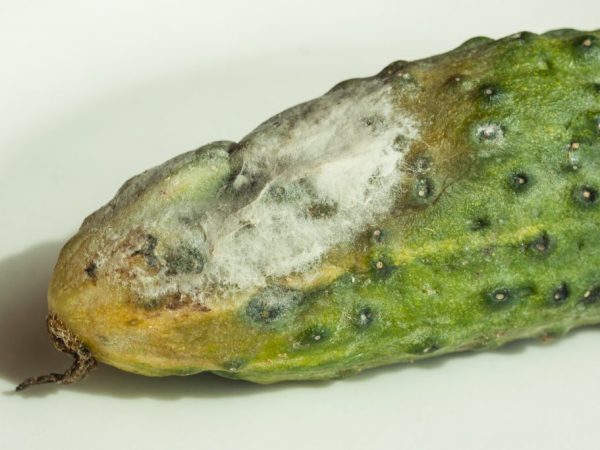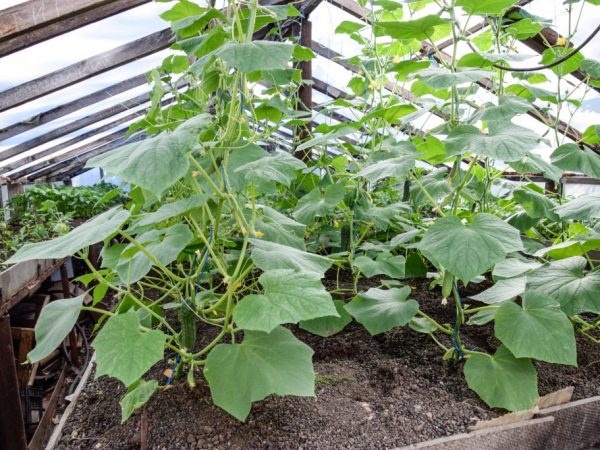Why does gray rot appear on cucumbers and how to deal with it
Cucumbers, ideal not only in appearance, but also in taste, are the reality that greenhouses gave us. But the artificially created climate is ideal not only for the growth of the beds, but also for the development of various bacteria. Fungal diseases affect many crops, and cucumbers are no exception. Today we will figure out what gray rot on cucumbers is and how to deal with it.

Gray rot on cucumbers and how to deal with it
What is gray mold
To combat the disease, it is necessary to correctly diagnose. Let's consider the characteristic features. Gray mold is a common bacterial contamination. The culprit of its appearance is the mushroom Botrytis cinerea. It infects leaves and fruits, covering them with an abundant gray bloom. The affected parts of the plant actively rot, and when the stem is infected, the entire bush soon dies.
Light brown vague spots on cucumber leaves are the first signs of infection.
Further, gray rot begins to affect the fruit, covering it with spots. With a complete defeat by spores, the fruit becomes very soft and watery, covered with a gray fluff. The insidiousness of this disease is that it very quickly infects neighboring crops, subsequently destroying them.
Reasons for the appearance
Gray rot on cucumbers in a greenhouse can appear for a number of reasons:
Temperature violation
Sudden changes in temperature always have a detrimental effect on plant growth. Decreased immunity exposes the seedling to fungal attack. Therefore, on average, the air temperature should remain from 22 to 28 degrees during the day and from 18 to 22 degrees at night. Overheating is considered a temperature above 30 degrees during the day and 23-24 at night, which provokes accelerated aging of the plant. If the temperature drops to 8 degrees Celsius for more than a day, irreversible disturbances begin in growth.
Improper watering
Cucumbers are watered with settled water at room temperature under the root using a watering can with a spray. At air temperatures above 25 degrees, it is necessary to start daily sprinkling. But it is worth observing the measure in the amount of water, since excessive moisture provokes rotting of the plant. The soil should be moist, not wet.
Attachment to one place
It is strongly not recommended to plant cucumbers in the same place every year. This depletes the soil, spreading the disease to all subsequent crops. To get a good harvest, you can plant cucumbers in place of cabbage, tomatoes or potatoes.
Unregulated humidity
Both the lack of moisture and its surplus pose a threat to sowing. During the seedling period, the air humidity required for cucumbers is 70-75 percent, with a normal relative humidity of 85-95 percent. As for the soil, moisture should be moderate before flowering, and then rise to 80%.
Excess fertilization
Never overfeed your plant with fertilizers. This primarily applies to substances containing nitrogen. Moderate feeding is done in four stages: 1 - 15 days after planting, 2 - when flowering begins, 3 - during fruiting, 4 - towards the end of the fruiting period.
Lack of ventilation

Regular ventilation is required
Without airing in the greenhouse, moisture will increase, which is fraught with the beginning of rotting. To ensure air ventilation in the greenhouse, it is enough to leave the doors open for 2-3 minutes once a day.
Tightness
Even with a small area, it is recommended to plant crops at least at the minimum necessary distance from each other in order to slow down possible infection. Optimal for this type of plant is a distance between the bush of 15-20 cm.
Ignoring disinfection
You always need to take a responsible attitude to the decontamination of the soil in the greenhouse.
To do this, you can use formalin, fungicides or pesticides, for which dust is introduced into the beds.
If you do not follow the precautions, the above factors can cause the onset of the disease. And as you know, it is much more difficult to carry out the treatment itself than prevention.
Control methods
The fungus is capable of destroying your crop in the shortest possible time, and therefore you need to master the methods of dealing with this disease in advance. With prophylaxis, cucumbers can be made resistant to spore infestation. But when the first signs of the disease appear, it is immediately worth starting the treatment of your garden.
Watering immediately stops and all damaged leaves are removed. Then carefully inspect the stem: if it is weakly damaged, then it is enough to sprinkle it with lime, if it is strong, it is better to cut it out immediately without giving in to treatment, and treat the sections with a solution of copper sulfate. When the fruits are already damaged, it is too late to fight, they need to be removed, and then the plant must be treated with special means
Care products
- For dusting, a dry mixture of a teaspoon of copper sulfate and a glass of wood ash is suitable. You can also use the option with the addition of a glass of chalk.
- Common purchased products: "Rovral", "Hom", "Baylon", etc.
- Bordeaux liquid is used in the proportion of 20 grams of copper sulfate per five liters of water.
- You can treat the plant with a five-liter solution with the addition of five grams of vitriol, 5 grams of urea and half a gram of sulfuric zinc.
- A proven remedy is chalk and water in a one-to-one ratio.
How to prevent disease
Taking into account the above factors of the appearance of infection, a number of basic requirements for caring for the garden can be distinguished. Be sure to purchase seeds from specialized stores and decontaminate them before planting. Conduct feeding, airing and watering competently.
Consider crop rotation when making room for cucumbers. We recommend planting the ground after the cucumbers with calendula flowers or mustard. This will help destroy any rot spores in the soil. Also, thin out bushes, as lush plants touch each other, more likely to transmit fungal spores.
Conclusion
Cucumber is a popular vegetable that takes its rightful place in the life of every person in every corner of the world. It is 95 percent water, therefore it is excellent at removing toxins, which also contributes to weight loss. Helps to improve the functioning of organs in kidney stones, maintain blood sugar levels, and improve bowel function.
Cucumbers are rich in B vitamins, vitamin C, iron (purifies the blood), magnesium and many other beneficial substances. This vegetable is often used for cosmetic purposes. Face masks can refresh the skin by giving it tone, while hair masks can help strengthen hair and remove excess oil.
Agree, it's a pity to lose such a useful crop because of your carelessness. Therefore, be vigilant and protect your greenhouse garden.


